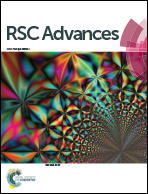Dual applications of silver nanoparticles incorporated functionalized MWCNTs grafted surface modified PAN nanofibrous membrane for water purification†
Abstract
An appropriate choice of material and tenacious substrate is imperative to accomplish the development of membrane based point-of-use materials. Herein, we have developed silver nanoparticles (Ag NPs) incorporated carboxylated multiwalled carbon nanotubes (MWCNTs) grafted aminated polyacrylonitrile (APAN) based nanofibrous membrane pertinent for the removal of toxic heavy metals and bacteria present in water. The intermediate product formed in the interim of the membrane preparation has the potential for the filtration and adsorption of heavy metals whereas, the final nanofibrous membrane is found to have exceptional antibacterial properties as well as filtration capability. Analytical techniques such as field-emission scanning electron microscopy (FE-SEM), Fourier transform infrared spectroscopy (FTIR) and transmission electron microscopy (TEM) corroborated the functional modifications and integration of Ag/PEGylated MWCNT–COOH nanocomposites with the APAN nanofiber mats. Thermal and mechanical studies revealed improved stability and tensile strength of the nanofibrous membrane. The kinetic and isotherm model investigations indicated the adsorption properties of the APAN nanofibers. Bacterial viability assay, fluorescence microscopy and spectroscopy analysis, disc diffusion studies and electron microscopic imaging of the membrane after the filtration was investigated. Comprehensively, our results put forth the candidature of APAN–Ag/PEGylated MWCNT–COOH nanofibrous membrane to be used as an impending point-of-use water purification material.



 Please wait while we load your content...
Please wait while we load your content...